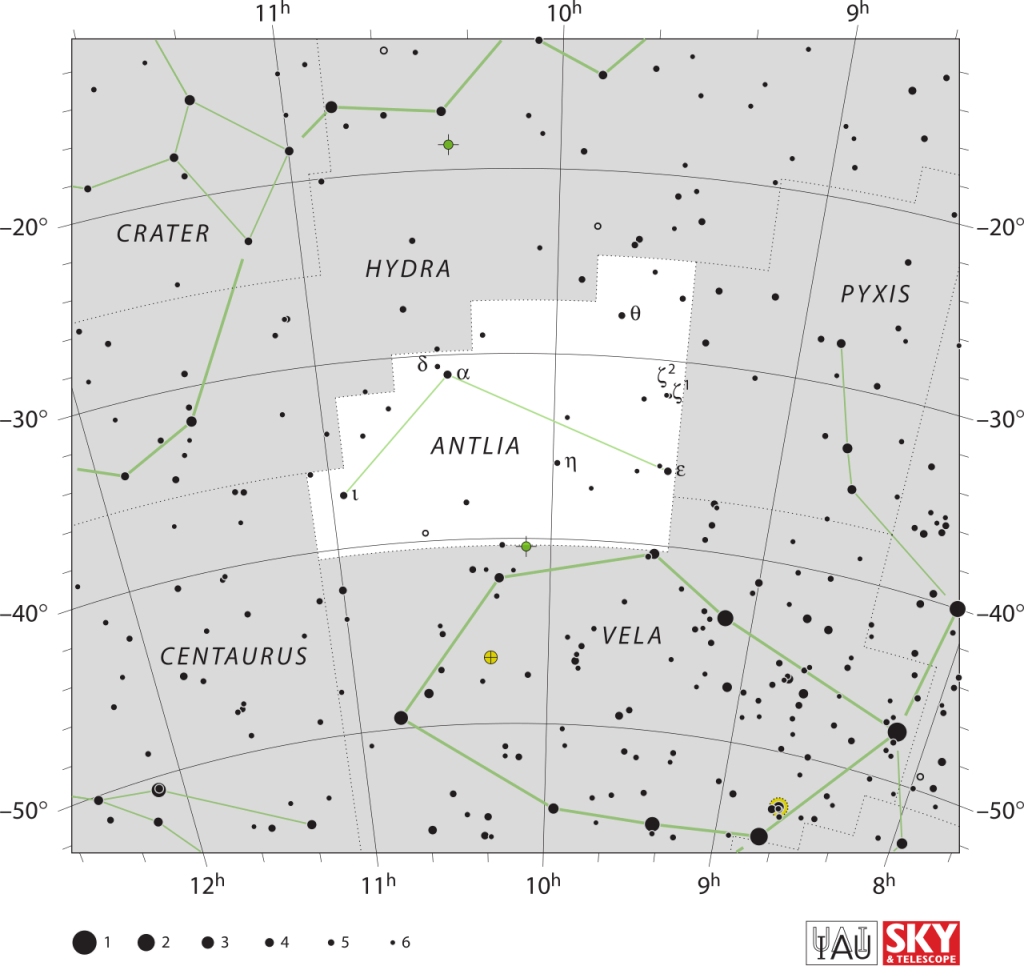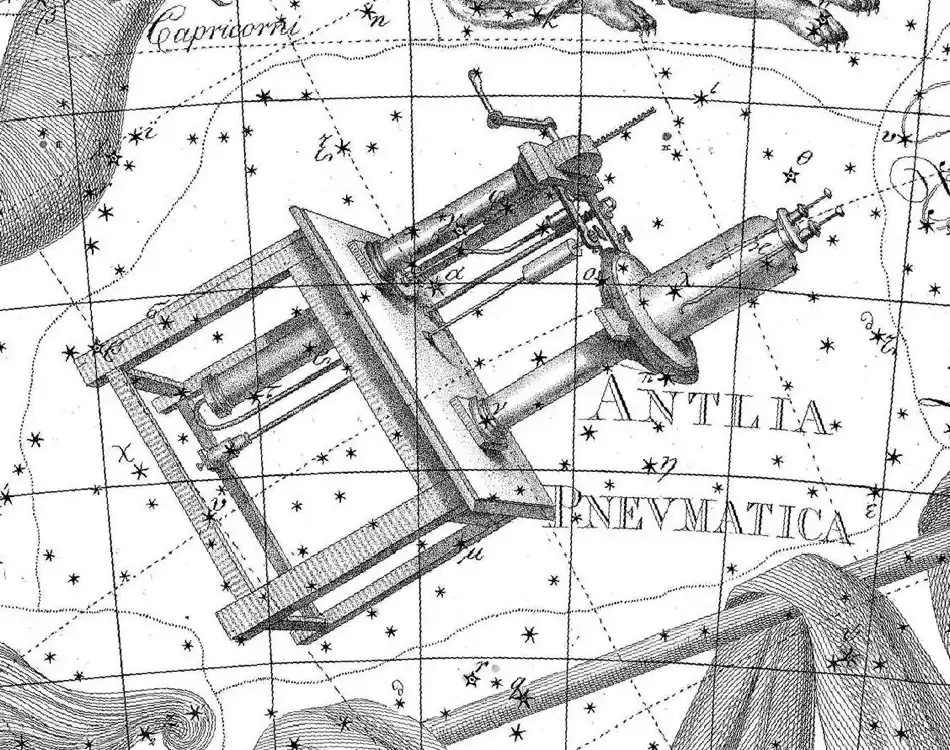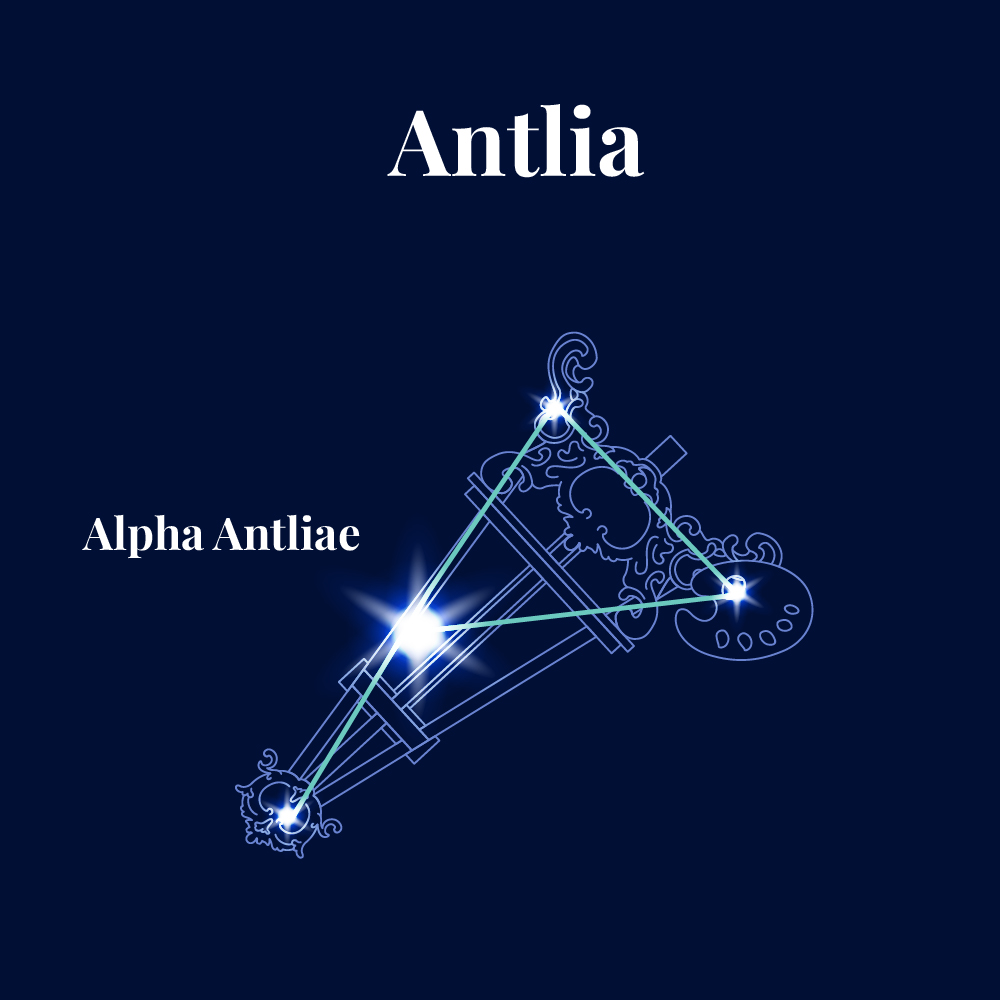The Air Pump of the Night Sky
Table of Contents
Historical Background
French astronomer Nicolas-Louis de Lacaille (1713-1762) introduced Antlia in his work during 1751–52, naming it “la Machine Pneumatique” (the Pneumatic Machine) to honor the air pump invented by French physicist Denis Papin. Lacaille catalogued nearly 10,000 southern stars throughout his career and devised fourteen new constellations during his stay at the Cape of Good Hope, focusing on regions of the sky previously uncharted by European astronomers.
Initially depicted as a single-cylinder vacuum pump, Antlia was later portrayed by German astronomer Johann Bode (1747-1826) as a more advanced double-cylinder version. Lacaille Latinized the name to Antlia pneumatica on his 1763 chart. By 1844, the famous English polymath Sir John Herschel (1792-1871) proposed shortening the name to one word, Antlia, which was universally adopted by the astronomical community.
Despite being visible to the Ancient Greeks, the stars of Antlia were too faint to be recognized as a distinct constellation in ancient times. The stars of Antlia were not part of any classical astronomical depiction. Argo Navis, originally one of Ptolemy’s 48 Constellations, representing the ship of the Argonauts, was eventually split into smaller constellations by Lacaille in 1763, establishing the constellation of Antlia.
Characteristics and Location
Covering an area of 238.9 square degrees, Antlia ranks 62nd in size among the 88 modern constellations. It is situated in the Southern Celestial Hemisphere and is entirely visible from latitudes south of 45 degrees north. Hydra, the sea snake, borders Antlia to the north, while Pyxis, Vela, and Centaurus lie to the west, south, and east, respectively.
The constellation’s official boundaries were defined by Belgian astronomer Eugène Delporte (1882-1955) in 1930. In the equatorial coordinate system, Antlia’s right ascension coordinates lie between 09h 26.5m and 11h 05.6m, and its declination coordinates range from −24.54° to −40.42°. The three-letter abbreviation for Antlia, as adopted by the International Astronomical Union, is “Ant.”

Stars of Antlia
Antlia contains a relatively modest collection of stars, with 42 stars brighter than apparent magnitude 6.5. Nicolas-Louis de Lacaille initially gave nine stars Bayer designations, labelling them Alpha through to Theta, and combining two stars as Zeta. Later, astronomer Benjamin Gould added Iota Antliae to the list. However, Beta and Gamma Antliae, initially part of Antlia, were reassigned to the neighboring constellation Hydra when the constellation boundaries were established in 1930.
The Bayer Designation
Before we continue to explore the stars of Antlia, let’s familiarize ourselves with the Bayer designation of stars, which is used widely in astronomy.
The Bayer designation is a stellar naming system introduced by the German astronomer Johann Bayer (1572-1625) in his star atlas, Uranometria. This system assigns a Greek letter, followed by the genitive form of the constellation’s Latin name, to each star within a constellation, typically in order of their apparent brightness. For example, the brightest star in a constellation is usually labeled Alpha (α), the second brightest Beta (β), and so on.
In the case of Antlia, the brightest star is Alpha Antliae (α Antliae), an orange giant suspected of being a variable star. Following this pattern, other stars in Antlia include Epsilon Antliae (ε Antliae) and Iota Antliae (ι Antliae), named according to their relative brightness within the constellation. This method provides a standardized way of identifying and referring to stars, facilitating easier communication and study among astronomers.
Now, let’s get back on track with the notable stars of Constellation Antlia.
Alpha Antliae
The brightest star in the constellation, Alpha Antliae, is an orange giant of spectral type K4III. It is a suspected variable star, with its brightness ranging from magnitudes 4.22 to 4.29. Located approximately 320 light-years from Earth, Alpha Antliae is an aging star on its way to becoming a Mira variable, having exhausted its core fuel and converted it into carbon. It shines with a brightness around 480 to 555 times that of the Sun.
Epsilon Antliae
Another prominent star, Epsilon Antliae, is an orange giant of spectral type K3 IIIa, situated about 590 light-years from Earth. It has a diameter about 69 times that of the Sun and a luminosity of approximately 1279 Suns. Epsilon Antliae exhibits slight variability in its brightness.
• Iota Antliae: Located 202 light-years away, Iota Antliae is an orange giant of spectral type K1 III. This star contributes to the constellation’s subtle reddish hue.
Delta Antliae
Near Alpha Antliae, Delta Antliae is a binary star system, about 450 light-years from Earth. The primary star is a blue-white main sequence star of spectral type B9.5V with a magnitude of 5.6, while the secondary is a yellow-white main sequence star of spectral type F9Ve with a magnitude of 9.6.
Zeta Antliae
This wide optical double star consists of Zeta1 Antliae, a binary system of two white main sequence stars separated by 8.042 arcseconds, and Zeta2 Antliae, a magnitude 5.9 star located about 386 light-years from Earth.
Eta Antliae
Another double star system, Eta Antliae features a yellow-white star of spectral type F1V with a magnitude of 5.31, and a fainter companion with a magnitude of 11.3.
Theta Antliae
Theta Antliae is a double star, likely comprising an A-type main sequence star and a yellow giant.
S Antliae
This eclipsing binary star system varies in apparent magnitude from 6.27 to 6.83 over a period of 15.6 hours. Classified as a W Ursae Majoris variable, the primary star is hotter than the secondary, and their mutual eclipses cause the observed variability in brightness. The primary star has a mass 1.94 times that of the Sun and a diameter 2.026 times larger, while the secondary has a mass 0.76 times that of the Sun and a diameter 1.322 times larger. Sharing a common envelope, these stars are expected to merge into a single fast-spinning star in the future.
T Antliae
A yellow-white supergiant of spectral type F6Iab, T Antliae is a Classical Cepheid variable star, ranging in brightness from magnitude 8.88 to 9.82 over a period of 5.9 days.
U Antliae
This red carbon star is an irregular variable, fluctuating in brightness between magnitudes 5.27 and 6.04. Located about 910 light-years from Earth, U Antliae is approximately 5819 times as luminous as the Sun!
BF Antliae
A Delta Scuti variable star, BF Antliae exhibits a slight variation in brightness, changing by 0.01 magnitude.
HR 4049 (AG Antliae)
An unusual hot variable star of spectral type B9.5Ib-II, HR 4049 is undergoing significant mass loss. This star does not belong to any known class of variable stars, with its brightness varying between magnitudes 5.29 and 5.83 over a period of 429 days. It is located around 6000 light-years from Earth.
UX Antliae
An R Coronae Borealis variable star, UX Antliae has a baseline apparent magnitude of 11.85, with irregular dimmings that drop its brightness below magnitude 18.0. This luminous and remote star is a supergiant with a spectrum similar to an F-type star, but it contains almost no hydrogen.
Deep-Sky Objects
Antlia contains several notable deep-sky objects, though many are faint and require telescopes to observe.
NGC 2997
The brightest galaxy in Antlia, NGC 2997 is a loosely wound face-on spiral galaxy of type Sc, with a magnitude of 10.6. While it may appear nondescript in amateur telescopes, it reveals bright clusters of young stars and dark dust lanes in photographs.
Antlia Dwarf Galaxy
Discovered in 1997, this 14.8 magnitude dwarf spheroidal galaxy is part of the Local Group of galaxies.
Antlia 2
A satellite galaxy of the Milky Way, Antlia 2 was discovered in 2018 near Epsilon Antliae. It is notable for its very low surface brightness.
Antlia Cluster (Abell S0636)
Part of the Hydra–Centaurus Supercluster, the Antlia Cluster is one of the nearest galaxy clusters to the Local Group, following the Virgo and Fornax Clusters. Situated 40.5 to 40.9 megaparsecs (132.1 to 133.4 million light-years) from Earth, it boasts giant elliptical galaxies NGC 3268 and NGC 3258 as its central members. The cluster is composed of around 234 galaxies.
Antlia Supernova Remnant
One of the largest supernova remnants in the sky, the Antlia Supernova Remnant is a significant deep-sky object within the constellation. Its vast size makes it an intriguing object of study for astronomers investigating the aftermath of stellar explosions.

Mythological Connections
While Antlia does not have a rich mythology of its own, being a modern constellation, its stars reside in a region of the sky associated with the ancient Greek constellation Argo Navis. Argo Navis represented the ship of Jason and the Argonauts from Greek mythology. This ship was believed to have sailed to Colchis in search of the Golden Fleece. Due to its immense size, Argo Navis was later divided into smaller constellations, including Vela (the sails), Carina (the keel), and Puppis (the poop deck).
In non-Western astronomy, Chinese astronomers also recognized the stars of Antlia, and put them into two different constellations. Stars in the southern part of Antlia were part of “Dong’ou,” representing an area in southern China, while Epsilon, Eta, and Theta Antliae were included in the Celestial Temple, along with stars from the modern constellation Pyxis.
Observational Highlights
Observing Antlia requires a dark sky location due to its faint stars. Here are some tips and highlights for amateur astronomers and stargazers:
Alpha Antliae
As the brightest star in Antlia, Alpha Antliae is relatively easy to locate with binoculars or a small telescope. Its subtle variability and orange hue make it an interesting target.
NGC 2997
Observing this spiral galaxy requires a telescope. Its bright star clusters and dust lanes can be seen in detail with larger telescopes and astrophotography equipment.
Epsilon Antliae
Another target for small telescopes, Epsilon Antliae’s brightness and reddish color make it a distinctive object in the constellation.
Double Stars
Zeta Antliae and Eta Antliae are both double stars that can be resolved with a telescope. Their contrasting colors and magnitudes provide a beautiful visual treat.
Variable Stars
S Antliae and T Antliae offer opportunities to observe stellar variability. Keeping a log of their brightness changes over time can be a rewarding experience for amateur astronomers.
Modern Research and Discoveries
Antlia is an important subject of interest for modern astronomers. Research into its stars, particularly those with companions, provides valuable insights into planetary formation and stellar evolution. The discovery of the Antlia 2 galaxy in 2018, with its extremely low surface brightness, has opened new possibilities for understanding satellite galaxies and the structure of our own home galaxy, the Milky Way.
Moreover, the Antlia Cluster and its member galaxies are important for studying galaxy clusters’ dynamics and the large-scale structure of the universe. The ongoing exploration of the Antlia Supernova Remnant contributes to our knowledge of supernova explosions and their impact on the interstellar medium.

